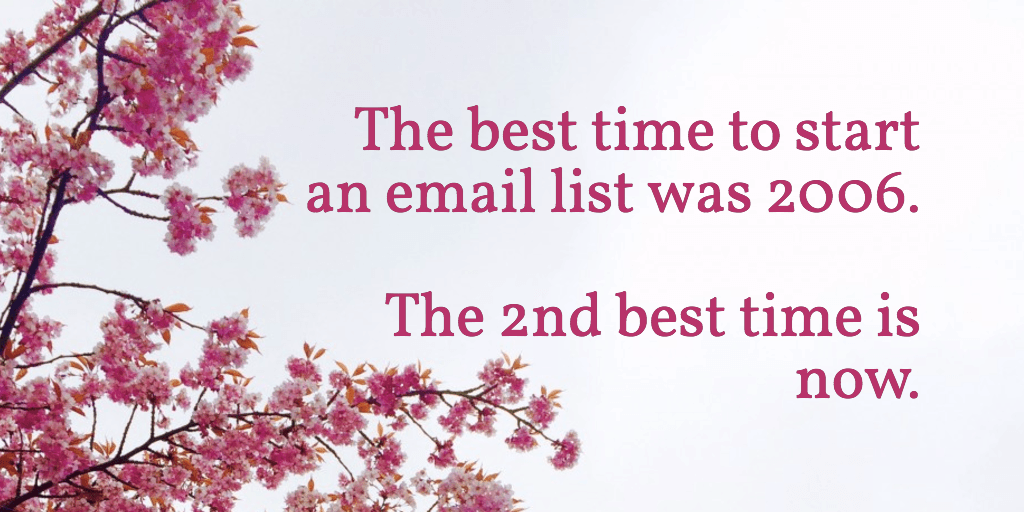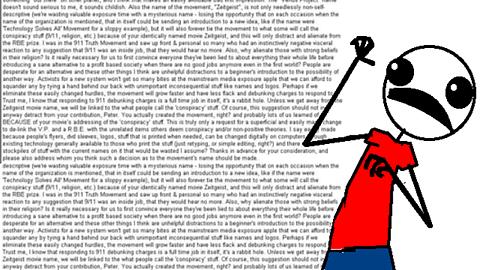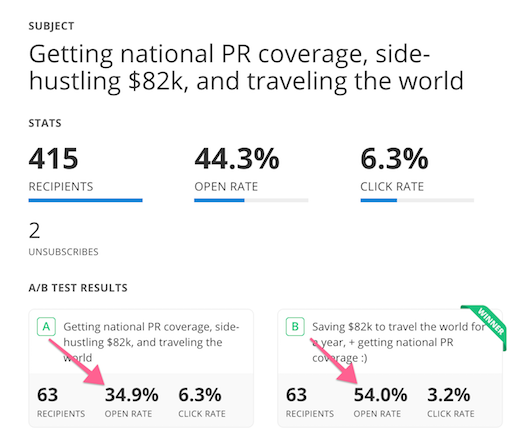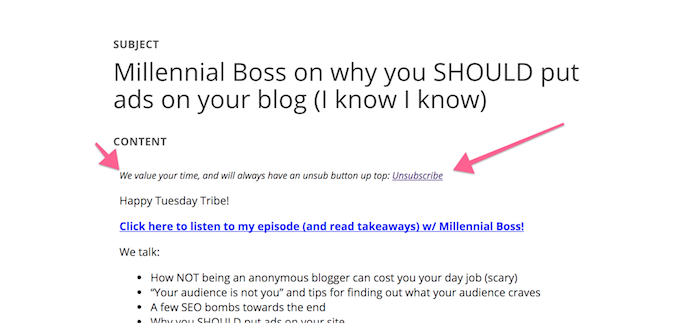A consolidated list of the internet’s 20 essential email list building strategies for beginners.
***
Raise your hand if you’ve heard this advice before…
“Starting an email list is THE first and most important step for any blogger’s growth, no matter their follower size!”

Of course you have. It’s shouted at you from experienced bloggers and influencers everywhere…but here’s the thing….
They’re right.
Email marketing is the most powerful marketing channel for bloggers, and should be treated with massive care!
***
Before we go any further, I want to express the importance of creating opt-in forms that STAND OUT with your audience.
My audience is bloggers (duh)–so whenever I make opt-ins, I try to take them a bit by surprise.
This is my email list guarantee.
We do not spam. We do not hit you with sales emails every day for 14 days straight. 😃
We do love to talk about blogging, digital marketing, side hustles, and making a living in online business.
Our newsletter will not disappoint. Join us today to start receiving exclusive content we don’t publish on the blog.
<3
Why is email marketing important?
An “email list” is a collection of your readers/fans’ email addresses, which you plug into software (ESPs), sending communications to your audience!
Here are other popular channels of communication to your audience:
- Facebook marketing
- Twitter marketing
- Pinterest marketing
- SEO
- other meaningless channels that are likely a waste of time.
What do all those marketing channels have in common?
You don’t have control over whether or not your content is actually put in front of your audience.
No control = bad.

FB, Twitter, Google, Pinterest, etc….these use fancy-pants algorithms that choose what to show to whom at what times.
You post a tweet/FB post/Pin with your content…and you audience could never lay eyes on it (maybe they don’t check Twitter that day? Or Facebook doesn’t include your post in their newsfeed?)
Email is different.
You’re in control, and there is a 100% chance your subscribers will see you’ve communicated something to them (unless they never ever check their email again I suppose?).
If they check their email 17 days after you sent your newsletter, it’ll still be there. (They could insta-delete it of course, but let’s discuss that later).
What sort of things do I email my email list?
Suzi from Start a Mom Blog lists the following:
- A welcome series
- An email course
- Content upgrades / freebies
- Your latest blog post
- An occasional tip
- Weekly round-up
- Survey or personal email with some questions
- Upsell from recent purchase
For beginning bloggers, I’d recommend the following:
- Sign up with Mailchimp to start (upgrade to ConvertKit once you have more experience and revenues)
- Publish blog/podcast/video content
- Email your list 2-3 times a month with personal, engaging emails, and let them know what you’re up to!
Keep it simple and point them to your latest posts, or tell them news about your life and blog (don’t waste their time though. Only communicate things they’ll find interesting, fun, helpful, valuable, etc.)

20 Essential Email List Building Strategies for Beginners
1 – Get started today
As already mentioned, even the “pro” bloggers are often heard saying they wished they’d started an email list sooner.
Tim Ferriss, Pat Flynn, Amy Porterfield. They’ve all said this.
- If you don’t already have a list, start one today.
- If you have a list but don’t focus on it, start focusing on growing it! It’s important!
In fact, Sarah Peterson from Unsettle.org started her email list *before* she launched her blog. She put up a simple landing page with a paragraph or two explaining what her blog was *going* to be about, and offered a content upgrade before she even launched.
She grew an email list before she started blogging, and come launch day? She have over 4k pageviews the first day.
Impressive.
Learn from her, and start growing an email list ASAP. The future blog traffic and revenues will thank you!

2 – Choose the best email marketing software **for you**
Here’s the thing about me (or any other blogger recommending an ESP for you):
We’re all biased towards affiliate commissions.
Sign up for ConvertKit using my affiliate link, and I get a cut of the profits. So, while we recommend ConvertKit (it is awesome) over and over again, just be aware that we’re searching for affiliate income.
And that’s ok, but…
Under no circumstances should you, a newbie blogger, start off with ConvertKit (sorry CK. love u). Start with a free and powerful platform like Mailchimp.
Once you learn what the heck you’re doing (let’s face it. If you’ve been blogging for less than 6 months, you don’t know what you’re doing yet), THEN switch to CK, or Aweber, or InfusionSoft.
See the email service provider guide below for more reviews and info.
3 – Content upgrades, freebies, and other delicious incentives
Tell me if you’ve seen these:

Opt-in forms with no personality and absolutely no incentive to join. (Also, who wants to receive more ‘notifications’ of any kind? That word holds a negative connotation for most folks).
Also, this is from a DYEB reader. Sorry 🙁
Give me something I want or need, and I’ll join your email list. (content upgrades aside, at least relay some sort of benefit or call to action. Maybe “Join our infrequent newsletter and receive exclusive content not available on the blog.”)
Question: Pete, what is a content upgrade?
Answer: A premium piece of content you give away for free in exchange for peoples’ email addresses.
Question: Ok, what’s an example of a ‘premium piece of content?’
Answer: I list a ton of them just below this section.
Question: Why does this work so well?
Answer: It’s essentially “selling” your readers something they want (hopefully), for emails, rather than money. They can always opt-out later, making it very low risk.
Question: How do I technically deliver these content upgrades?
Answer: It’s complicated. See below.
Sadly, the technical delivery of content upgrades will depend on your chosen ESP, as well as any additional list-building software you use (Sumo.com? Thriveleads? Leadpages? etc).
In general, the simplest way for beginners to set up a content upgrade is through their auto-responder. Log-in to your ESP and upload your pdf, video, etc…to your auto-responder. (If you don’t know what an auto-responder is, click here to learn more).
Listen up.
***
Content upgrades aka “freebies,” are the single best way to grow an email list in a semi-passive manner.
***
Choose the content upgrade you want, create it, and deliver it using your ESP or list-building software.
3.5 – Loads of freebie/content upgrade ideas
There are only 2 rules when creating a content upgrade:
- Make sure it’s something your audience WANTS, or values.
- Make sure it’s something your audience WANTS, or values.
See what I did there?
If you’re creating a freebie for a specific post or page, it might help to make it relevant to the post content.
Here are a load of content upgrades ideas:
- bonus video – Repurpose your current blog post (or pro tip: your best performing blog post to date) into a 5-10 minute video. DON’T overthink production. Just start talking to your webcam or iPhone. Seriously. Try to deliver content, and stop focusing on production quality. Just use YouTube or a free Vimeo account.
- bonus audio (podcasts rock!) – Same as above. Repurpose your existing content to audio, for people on-the-go. (I intake 80% of my content these days via audio.) Just start by uploading to free Dropbox or Google drive, then linking to audio files for delivery….or start a podcast on the cheap and easy with Podbean (it’s who I use). If you want to learn more, take my free podcasting course here.
- infographics – Use Snappa (free and paid) or Canva (free but annoying) and use one of their pre-made infographic templates. It’s easy, kind of fun, and could be a fun addition to your content.
- checklists – If you’re teaching something, providing instructional content, and handy checklist (limit it to 1 page please) could be an amazing and easy freebie. Example: For this “how to build your email list” blog post, I could make a “7 things every blog post NEEDS for list growth” checklist.
- “cheat sheet” – Kinda like the checklist above, this should be a short and simple summary of a given topic. No reading for 20 minutes…just the important bullet points and 1-2 sentences of explanation.
- ebook or long-form content – this content shouldn’t be available anywhere else. I personally don’t find these as valuable.
- “A chance to win” – something. I had great success giving away “dollar boxes” for my old personal finance site. It was a small grab-bag of personal finance stuff I physically mailed people. They loved it 🙂
- Free course – I recommend email courses, as people generally know what they’re signing up for. Both Mailchimp and ConvertKit have systems to deliver these! See that free
podcasting course I mentioned a second ago? Prime example. - Any other valuable something 🙂 – Let your imagination run wild. The trick is to create something desirable for your audience!
4 – Text 5 people in the next 5 minutes and get them on your list
I love this.
Many bloggers have a fear of asking for anything, including their audiences email address. Get over that fear ASAP.
Furthermore, what’s the point of list building again?
Effective communication with raving fans that know and trust you.
And who are some other people that know and trust you, and are prime candidates for becoming loyal fans, no matter what??
The top 5 people in your address book (i.e. smartphone).
What to build an email list but not sure how to start? Or having a rough blogging day and need a quick pick-me-up? Text 5 people you love, tell them you love them, inform them what you’ve been up to, and ask them to join your list. Use this:
“Hey mom! Just texting to say I love you and miss you, and that I’ve recently started a mom blog! I’m enjoying the writing process, it’s a ton of fun. Want me to send you my next post? Thought you might enjoy it :)”
Who would say ‘no’ to that?
5 – Reach out to your first 100 subscribers manually and onboard them
Same deal as above.
In Bryan Harris’s 10K Subscribers course, this is his lesson #1. 0-100 subscribers. Call, text, or Facebook message (no email preferably) and use the same template as above.
These people do not have to be in your niche.
They DO have to know, trust, and like you. They will be your early blog ambassadors, will likely share your content (simply because they know you)….and they’ll be the cornerstone of a healthy and growing email list.
0-100, and don’t cut corners. Don’t message 12 people and say “eh that’s enough I get the point.”
That’s what average bloggers do. Don’t be average.
6 – Produce kickass content worth reading, sharing, and sharing again.
But y’all already know that so…
Seriously though. Content is king, still. Especially going into 2018 with more blogs coming online in every niche.
I won’t spend forever on this, but you must, must, MUST focus on creating content that is worth reading. Only you and your audience can really define what that looks like explicitly, but it’s a mandatory for successful blogging.
Here’s a 10-second summary through Pete’s eyes:
- Do more research for topics you’d like to teach on
- Make content longer, but more skimmable.
- Try different formats (podcasting hellllooo)
- When you think it’s done and ready for publish? Make it 20% longer and better, then edit 40% of it out. In that order.
- Don’t settle for mediocre content just because it’s there on the WordPress dashboard, and the publish button is so close, and you neeed content to go out today.
7 – Run giveaways
This is more advanced strategy, and requires a bit of guts…but doesn’t have to be complicated!
- Pick something your audience, really, REALLY wants. It should be niche-specific (no iPad giveaways).
- It should be something worth opting in for. Would you opt-in to your own free e-course? NO. Give away $1,700 of travel gear, and you can be DAMN sure I’m going to sign up and share.
- Use a giveaway tool that encourages sharing (Kingsumo, raffle-copter, etc. Try out Amazon giveaways as well. Google it). This step is vital.
- Promote the heck out of the giveaway.
Simple, but not easy.
The cheap part of you is going to want to skimp on the object of the giveaway. This is almost always a sign a giveaway won’t perform as well as you’d like. You’re better off getting 700 new email subscribers giving away something that costs $1,000, than getting 25 email subscribers for something that cost $100.
Make it worth it. Here’s further reading for advanced email list builders!
8 – If you run paid ads, point people to your absolute best content
Not landing pages. People talk about “funnels” for a reason, and pointing paid reach directly to product pages or landing pages skips several steps in the funnel.
Skips important steps in the funnel.
You’re going to do better over the long run if you utilize paid reach to drive traffic to your *all-time best* pieces of content. This is advice from Bobby at MillennialMoneyMan.com (I’ve had him on the podcast twice. Here and here.), who gets incredible CTRs and low CPC’s with Facebook ads. (Like, $0.05 a click sometimes? Insane).
Think long-term. You’re trying to convert traffic into long-term raving fans, not short-term paying customers.
9 – Keep your emails worth reading(!)
Don’t send crappy emails. Ever.
Some tips for this:
- Keep your emails short and to the point. Don’t waste people’s time.
- Try to add value *within* the body of the email…though this is a bit more advanced.
- Use clear, conversational writing.
- Avoid “walls of text.” (see below).
- Occasionally, provide exclusive content to your subscribers. Some deal or piece of content that can’t be found anywhere else! This will encourage them to open future emails.

10 – Don’t ever be spammy. Ever.
Unfortunately, how often you email your list varies from blog to blog, niche to niche.
My niche is other bloggers. I CAN’T email them 3 times a week, like, ever. They don’t want that.
Scott’s cheap flights, on the other hand, I am thrilled with every email they send, and would open one every single day. It’s a different type of email w/ a different purpose.
Here are some things to keep in mind, though:
- Any email course you setup could potentially be sending automatically. So if someone signs up for a daily course w/ 5 lessons, and you send them 2 normal emails that same week….they have 7 emails from you in 7 days. That’s a lot. Be mindful.
- Sales weeks (i.e. weeks where you’re launching some product/service) often require more emails. This is tricky, especially for beginners. The key here is proper list segmentation and timing, which takes some technical skills w/ your ESP.
- In general, send helpful emails worth opening, and you should be fine.
11 – Don’t overcomplicate things. Keep it simple.
This is directly related to point #1 above (start collecting emails yesterday). The process of launching and growing an email list can be overwhelming.
You have to…
- learn the ESP
- reach out to people
- do tricks/tactics/hacks/freebies x,y,z, and a, b, and c.
- write good emails
- manage your list
- automate content upgrades and autoresponders
- and oh, yeah. keep blogging.
It’s….a lot.
You will do well to keep priorities straight. A+ content first and fostering your loyal tribe = FIRST. All fancy list-building stuff = SECOND.
Keep things simple to start. Use Mailchimp, email 3-4 times a month, and send short useful emails concerning your latest posts and news.
You can’t go wrong with this.
Add advanced techniques as you grow.
12 – Try different opt-in placements on your website
Chris at KeepThrifty.com found that when he placed his call-to-action email opt-in AFTER his content, it converted better than when at the top.
He believes it’s because his audience has read his content, has seen what he’s about, and trusts him more than before they read the content.
Seems about right.
Trust = more email opt-ins, more sales, more followers.
I’ve personally found my sidebar opt-ins perform best of all. I usually promote one. content upgrade at a time, but always in the same place.
Sadly, the only actionable advice to takeaway is this: everyone’s different, and you must experiment and test!
As my friend Noah Kagan would say…”track it or it didn’t happen.”
13 – Use free software to start. PLEASE.
Eden uses Thriveleads, OptinMonster is good, and I use Sumo.com.
Sumo is the only one of those with a robust suite of tools for growing an email list….for free. There is a paid plan, but you absolutely do not need it.
Especially when you first start!
Keep it simple, and don’t throw money at powerful features you don’t really need. Spend the time, energy, and capital on your content 🙂 🙂
14 – A/B test all subject lines
Every email service provider I’m aware of offers this, and it’s mandatory.
FYI, want to write subject lines that get more opens and more clicks? Check out my guide to writing AWESOME headlines using a headline analyzer tool. Hello better open rates 🙂
Here’s how A/B testing is used in email marketing (the simplest way at least):
- You choose 2 different subject lines
- You send each subject line email to a *small segment of your list*
- Based on which subject line had the best open rate after a few hours, your ESP automatically sends the “winning” subject line to the rest of your list.
For example…
Below is a recent email I sent in ConvertKit.
- I A/B tested 2 subject lines.
- A had 35% open rate after 4 hours
- B had 54% open rate after 4 hours.
- ConvertKit sent B to the rest of my list, leading to an overall open rate of 44%.
Not terrible.
A/B testing takes very little time, and can potentially do wonders for your open rates!

15 – Offer something exclusive just to email subscribers.
Don’t just spam your latest blog URL. This is what average bloggers do, and “average is for losers.”
On occasion, you need to provide something of value to your email subscribers that can’t be found anywhere else.
- Not on your blog
- Not in your Facebook group
- For your email subs only
Do this in addition to letting your fans know about your latest post, etc…and you will greatly increase the value of your emails.
For example….when I email my list about THIS very post…I’m going to include the content upgrade link for them…no opt-in required….as well as a bonus video. This won’t be found anywhere else. A treat for my subs!
Hopefully they’ll appreciate this 🙂
16 – Be different and creative
I place my unsubscribe button up TOP in all my email newsletters.
Why? Because I want more unsubscribers, duh.

Kidding.
I put an unsub button up top because I…
- Respect people as human beings (and never want them to have to SEARCH for that link)
- am different and creative.
I’ve received numerous compliments on this one silly idea.It makes people take notice.
Sure, people click it…but those people weren’t going to be long-term Do You Even Tribe members anyways!
Question for you…
What can you do different in your email marketing to stand out from your peers? Get noticed? Make people say “woah!” or “huh?”
To make impact, you’ve gotta be heard. And to be heard, you need attention. Grab it.
17 – Optimize your ‘home’ and ‘about’ pages.
Quick, head to my home page. What do you see?
My blog roll? A list of podcast episodes? 17 paragraphs about how amazing I am?
Nope. An opt-in.
My homepage is THE most visited page on my entire website, making it ideal for collecting emails.

Another fantastic place to put an honest and transparent opt-in is on your /about page.
(Mine is fairly well hidden, hence you don’t see it in the report about).
For one, it’s where your website traffic goes to learn about you, your blog, and your mission. This page should have reader TRUST at an all-time high!
And remember what we said?
Trust = more subs, more revenues, more rabid followers.
Sorry. Raving. I meant raving followers.
18 – Look for free or cheap (less than $300) courses on list building.
If you find a highly-recommended and reasonably-priced resource (like Eden Fried’s 30-day list building challenge), don’t be afraid to pull the trigger and learn as much as possible.
There are several amazing free list-building courses out there as well.
Leadpages has an amazing free course.
Bryan Harris has a nice course (WARNING: this is a funnel for his uber expensive 10K subs course, which I do not recommend). There’s still great stuff here though.
The biggest benefit of these types of learning channels is organization and consolidation of information (see next point)
19 – Don’t pay for ultra-premium online courses until you’re ready!
If you have one shred of “I don’t knooooowww….maybe I shoullddddn’t pull the trigger and pay $999 for this course on blogging….”
Don’t buy it. Period. (see my note about the 10K subs course above)
You’re not ready. The information, wisdom, and experience you seek is out there on the internet for free. You just need to find it.
Pay for expensive courses when you…
- Have the excess cash to pay for it (EASILY)
- Only need the course as a time-saver (like I said, the info is out there. Online courses are really just consolidated and organized information)
20 – Be patient, padawan
Though there are several tips in this guide aimed at getting you quick email list wins (namely running a giveaway, and manual outreach to people you already know), growing an email list takes time.
Growing an email list takes time.
Good news bad news:
- Bad news = It’s going to seem painfully slow at first (0 – 500 might take 12 months)
- Good news = it grows exponentially…eventually (10,000 – 25,000 might take 12 months)
Additionally, this is a HUGE list of email list building strategies. Beginners will 100% get overwhelmed at first, and likely lose focus. Start small, start simple, and learn over time.
***
New bloggers: Don’t get frustrated when content upgrades fall flat. List building takes time. The key to winning the blogging game is persistence and consistency. Keep pushing, and growth WILL come.
***
Which email service should I use for 2018?
Rather than providing broad “recommendations” that are really just for affiliate marketing income (heehee)…I’m going to straight up tell you what to use.
Seems uncomfortable and unfair, doesn’t it?
Probably, but that doesn’t mean I’m wrong. Based on where you are in your blogging career, you will need different services from your email platform. Here’s my take
- You have 0-1,000 email subs – Use Mailchimp.
- You have 1,000 – 10,000 email subs (OR make $250/month with less than 1,000) – Use ConvertKit (or maybe Drip)
- You have 10,000+ email subs – Use Infusionsoft
Reasoning –> You don’t need all those fancy tools you THINK you do. Stick with free Mailchimp to begin with. It’s easy, and it just works.
Once you get more experience (and revenues) under your proverbial belt, switch to ConvertKit for some power features (sequences are amazing, as are tag/segments).
Once you REALLY get cranking, switch to InfusionSoft for better pricing and more technical software.
Email service provider reviews for bloggers in 2018
View their pricing page here.
I’m not just saying this because they’re from Atlanta, but MC is an incredible platform. It’s free up to 1,000 subscribers or 2,000 monthly emails sent. VERY affordable, while still being incredibly easy to use.
It’s perfect for beginners, but they have super powerful features starting at about $10/month (still cheaper than ConvertKit’s smallest plan).
I’ve used Mailchimp on and off for over 5 years, and sincerely and honestly recommend them. No affiliate necessary.
View their pricing page here.
I’m currently using ConvertKit, for 3 main reasons:
- I find CK hits people’s inboxes way better than MC (MC tends to hit the “promotion” tab in Gmail.)
- I love, love, love the way CK segments and organizes subscribers. Tags/forms/segments are awesome.
- Sequences are extremely user-friendly and effective.
In general, these 3 are what made me switch from Mailchimp to ConvertKit, and I’m not looking back.
The problem?
ConvertKit does NOT have a free plan. It’s frustrating, and thus I can’t recommend it to newer bloggers. They simply don’t need the extra 10% features for the price. (Starts at $29/month and goes up QUICK as your list grows…).
Still, if you have experience and revenues, you should probably be using CK for anything less than 10k subs.
Though Drip does offer a small free version (up to 100 subs), it’s $41/mo up till 2,500 subscribers.
However, their platform is EXTREMELY user-friendly, with amazing features. I use Drip on a separate client project, and it has been wonderful to work with.
And once you get to the 1,000 sub mark, it’s actually more cost-effective than ConvertKit, with great features. HIGHLY recommended!
View their pricing page here.
Aweber had a huge market share of bloggers just a few years back, before ConvertKit entered the scene. Now they’re playing 3rd or 4th fiddle, so to speak.
Plans start at $19/month u to 500 subs (that’s fair), and ALL plans have ALL features.
Handy!
If you’re just not cold on Mailchimp or ConvertKit, give Aweber a try. It’s affordable, and has all the nice features you’d want, even in the low plans.
View their pricing page here.
- The good thing about AC is it has more robust features for marketing and sales (CRM tools included).
- The bad thing about AC is bloggers don’t really need most of those.
Plans start at $9/month, but those doesn’t include half the features. Frustrating. Not recommended for bloggers, unless you just NEED a CRM tool w/ Gmail extension functionality. (and if you do, just use Streak for free?)
View their pricing plan here. (scroll a bit)
Mailerlite is cool, and though I’ve never used it personally, it totally gets my recommendation.
For one thing, the pricing is very fair, and the feature list is comparable to ConvertKit. (landing page builder, embeddable form builder, unsubscribe page builder??)
I’ve seen Mailerlite recommended several times by bloggers I know and trust, and thus it gets my seal or approval.
Also, people speak wonders about their WordPress plug-in. Definitely worth trying if you want a slightly smaller price point than CK!
View their pricing page here.
Though CC has been around for ages, it’s not aimed at bloggers…it’s aimed at small businesses.
Simply put, don’t use CC. Their plans are terrible.
They only have two (the price scales w/ subscribers), and the lower one has NO automation tools? But is still expensive? Forget about it.
They’re not marketing to bloggers, and rightly so. The feature set and price point doesn’t make sense for us. Use CK or InfusionSoft
View their pricing page here.
Plans START at $99/month, but that’s ok. Infusionsoft isn’t aimed at everyday bloggers, they’re focused on the big fish.
IS features all the usual features, as well as advanced marketing and sales automations/tools. I’ve personally never used IS, but I do see it’s what a bunch of big name blogging “influencers” are using. Their features do look pretty sweet, but it’s definitely geared towards marketing professionals.
I.e. You start making $99k/month, and hire a digital marketer to run your campaigns. At which point, ya know, show your old friend Pete some love.
View their pricing page here.
Plans start a $79/month. This is also geared towards marketers, which is fine if you are one. If you’re not super gung-ho and saavy about marketing processees, then forget it. Not worth the features you’ll rarely use.
Use CK till you can afford a marketer, then IS.
Conclusion: Here’s what most bloggers should do:
New blogger? Start w/ Mailchimp because it’s powerful and free.
500+ subscribers w/ a little bit of cashflow? Switch to ConvertKit for powerful features geared towards bloggers.
10,000+ w/ lots of cash flow? Switch to Infusionsoft and hire a marketer 🙂
***
Want an inside look at my all-time best converting content upgrades? (hint: my top converts at 10%!)
Be sure to grab them by clicking the image below.
***
Thoughts on these email list building strategies? Comments? Questions? Long post! Please let me know if you finished!
Love you,
–Pete

